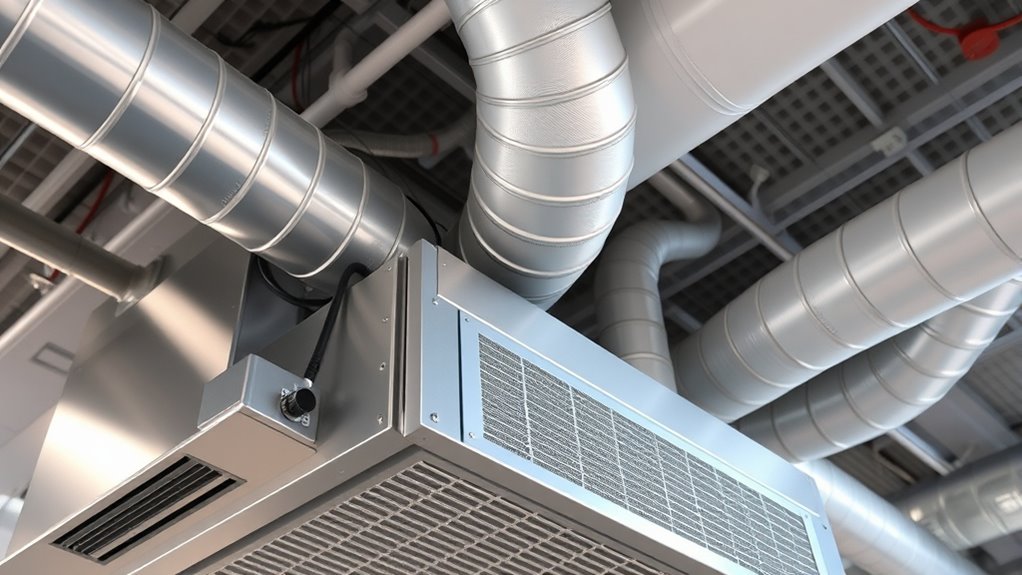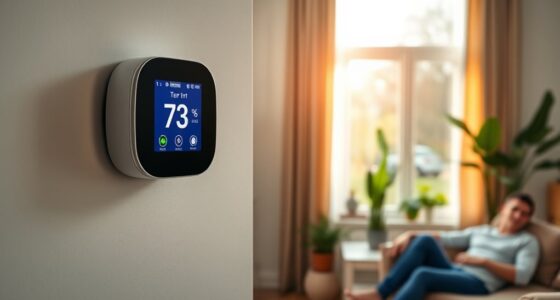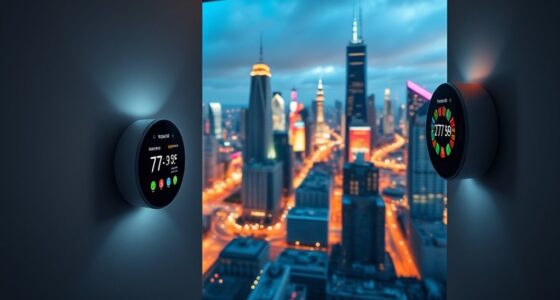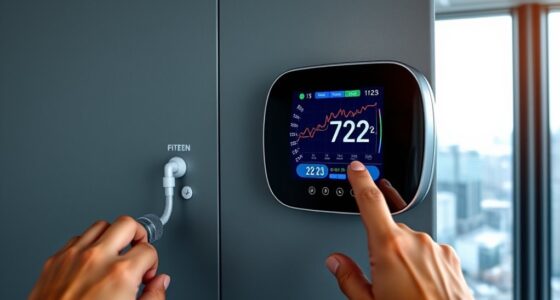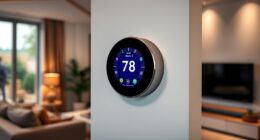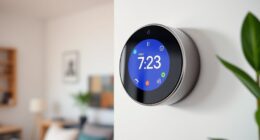An HVAC system is a setup that heats, cools, ventilates, and filters indoor air to keep your environment comfortable and healthy. It uses units like furnaces, air conditioners, or heat pumps, along with ductwork, filters, and smart controls to manage temperature and air quality. These systems constantly monitor settings and adjust operations for efficiency. To learn how each part works together for ideal comfort, keep exploring further.
Key Takeaways
- An HVAC system provides heating, cooling, and air circulation for indoor environments.
- It uses components like furnaces, air conditioners, ductwork, filters, and thermostats.
- Air is filtered, heated or cooled, then circulated through ducts to maintain comfort.
- Modern HVAC systems incorporate AI controls and energy-efficient designs for optimal performance.
- Regular maintenance ensures efficiency, prolongs system lifespan, and improves indoor air quality.
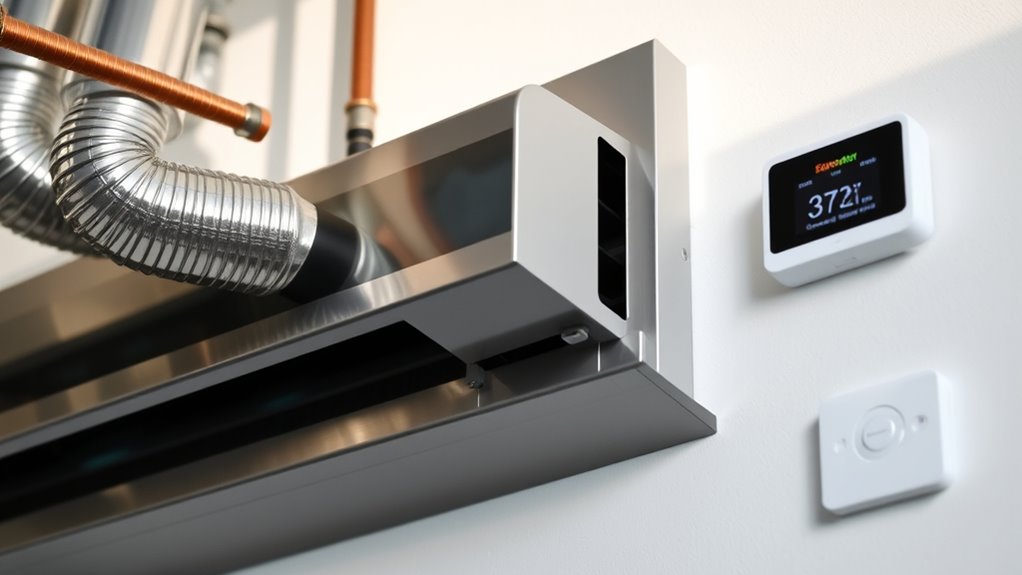
Have you ever wondered how your home stays comfortable year-round? It’s thanks to your HVAC system, a sophisticated setup that manages temperature, humidity, and air quality. At its core, an HVAC system uses different components working together to keep your indoor environment just right. One key aspect of its efficiency is air filtration, which ensures that the air you breathe is clean and free from dust, allergens, and pollutants. Good air filtration not only improves indoor air quality but also helps your system run smoothly by preventing dirt buildup on essential components. When your HVAC system is designed with energy efficiency in mind, it consumes less power, saving you money on utility bills while reducing your carbon footprint.
Your HVAC system keeps your home comfortable year-round with efficient air filtration and energy-saving features.
The process begins with the heating and cooling units, which are typically a furnace and an air conditioner or heat pump. When you set your thermostat, these units respond by activating to reach your desired temperature. The air inside your home is circulated through a network of ducts, where it passes through filters that trap particles, allergens, and other impurities. This step of air filtration is critical because it maintains healthier indoor air and prevents debris from clogging the system’s components, thereby increasing energy efficiency. Additionally, advancements in AI-powered controls are now being integrated into modern HVAC systems to optimize operation and further enhance energy savings. Incorporating advanced filtration technologies can significantly improve indoor air quality and reduce the burden on your system, leading to longer equipment lifespan.
When the air is filtered properly, your system doesn’t have to work as hard, which means it consumes less energy and lasts longer.
Once the air is cleaned, it’s conditioned—heated or cooled—depending on the season and your settings. The heated air is produced by your furnace, which burns fuel or uses electric resistance, then distributes it through ducts. During warmer months, the air conditioner or heat pump removes heat from your home, cooling the air before sending it back inside. Throughout this process, the system constantly monitors temperature and humidity levels to maintain a comfortable environment. Modern HVAC systems incorporate smart controls and programmable thermostats, which further enhance energy efficiency by adjusting operation based on your schedule.
To keep everything running at its best, regular maintenance is key. Changing filters, inspecting ductwork, and servicing the equipment ensures your system functions at peak efficiency. When your HVAC system is well-maintained and equipped with effective air filtration, it not only provides a comfortable indoor climate but does so in an energy-efficient way. That means lower energy bills, less environmental impact, and a healthier home environment. So next time you enjoy a cozy or cool room, remember it’s the result of a well-designed system working behind the scenes to keep you comfortable all year round.
Frequently Asked Questions
How Energy-Efficient Are Modern HVAC Systems?
Modern HVAC systems are quite energy-efficient, helping you save on energy consumption and reduce utility bills. They come with high efficiency ratings, often exceeding 90%, meaning they do a great job heating or cooling your space without wasting energy. You’ll notice improvements in comfort and lower environmental impact. Regular maintenance and choosing ENERGY STAR® models can further enhance your system’s efficiency, ensuring you get the most out of your investment.
What Maintenance Is Required for HVAC Systems?
Back in the day, maintenance was a breeze, but now, you need to stay on top of your HVAC system. Regularly replace filters to keep air clean and airflow efficient, and schedule system calibration to guarantee ideal performance. Don’t forget to check for refrigerant leaks and clean coils. These steps extend your system’s life, improve energy efficiency, and keep your home comfortable year-round.
Can HVAC Systems Improve Indoor Air Quality?
You can definitely improve indoor air quality with your HVAC system by incorporating air purification technologies and enhancing ventilation. Air purifiers filter out dust, allergens, and pollutants, making the air cleaner. Improving ventilation helps circulate fresh air and reduces indoor pollutants buildup. Regularly maintaining and upgrading your system guarantees these features work effectively, creating a healthier, more comfortable environment for you and your family.
How Long Do HVAC Systems Typically Last?
Think of your HVAC system as a loyal companion, aging gracefully over time. Its system lifespan usually ranges from 10 to 15 years, depending on maintenance and usage. When it nears the end of its journey, replacement costs come into play, like investing in a new chapter. Regular upkeep can extend its life, saving you money and ensuring comfort. Otherwise, be prepared for the eventual upgrade to keep your home cozy.
Are There Environmentally Friendly HVAC Options Available?
You’ll find plenty of eco-friendly options when choosing an HVAC system, thanks to advancements in green technology. These systems use less energy, reduce emissions, and often incorporate renewable energy sources. Look for units with high SEER ratings, ENERGY STAR certification, or those that utilize solar or geothermal power. By selecting these eco-friendly options, you help lower your environmental impact while maintaining comfort all year round.
Conclusion
Now that you understand how an HVAC system works, you can think of it as the gentle guardian of your comfort. It quietly weaves warmth and coolness into your home’s fabric, much like a soothing breeze on a warm day or a cozy blanket on a chilly night. With its steady touch, it keeps your environment just right, allowing you to relax and breathe easy, knowing that your comfort is always softly taken care of behind the scenes.
